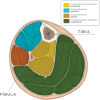Chronic Compartment Syndrome in Athletes
- PMID: 39649060
- PMCID: PMC11624925
- DOI: 10.1055/s-0044-1787766
Chronic Compartment Syndrome in Athletes
Abstract
Chronic compartment syndrome (CCS) is a pressure increase within a non-expandable fibro-osseous space resulting from continuous and intense physical activity. Its symptoms usually improve with rest or reduced activity. It is a critical cause of lower limb pain in athletes and the second most common cause of effort-related leg pain. Less frequent reports include CCS in the lumbar paravertebral compartments, in the hand, the forearm, the thigh, and the foot. Although CCS mainly affects long-distance runners, it may also occur in sports such as lacrosse, football, basketball, skiing, and field hockey. Muscle tension, cramps, symptoms worsening with physical exercise, pain, and reduced sensitivity in the upper part of the foot are the main CCS findings, and diagnosis is essentially clinical. Even though controversial and with some limitations, CCS diagnosis has relied on measuring the intracompartmental pressure after exercise. However, new alternative tools are under study, particularly those less invasive, such as magnetic resonance imaging (MRI) after the exercise protocol. For years, open fasciotomy was the most relevant treatment for CCS in athletes, but new surgical techniques are gaining importance, such as minimally-invasive fasciotomy and endoscopic procedures. Some conservative therapies hold promise as potential alternatives for patients who do not want surgery, but robust evidence to support them remains lacking, especially for athletes.
Keywords: athletes; compartment syndromes; sports injuries; sports medicine.
The Author(s). This is an open access article published by Thieme under the terms of the Creative Commons Attribution 4.0 International License, permitting copying and reproduction so long as the original work is given appropriate credit ( https://creativecommons.org/licenses/by/4.0/ ).
Conflict of interest statement
Conflito de Interesses Os autores não têm conflito de interesses para declarar.
Figures


References
-
- Alexander W, Low N, Pratt G. Acute lumbar paraspinal compartment syndrome: a systematic review. ANZ J Surg. 2018;88(09):854–859. - PubMed
-
- Willick S E, Deluigi A J, Taskaynatan M, Petron D J, Coleman D. Bilateral chronic exertional compartment syndrome of the forearm: a case report and review of the literature. Curr Sports Med Rep. 2013;12(03):170–174. - PubMed
-
- Dunn J C, Waterman B R. Chronic exertional compartment syndrome of the leg in the military. Clin Sports Med. 2014;33(04):693–705. - PubMed
-
- American Academy of Orthopaedic Surgeons.Compartment SyndromeAvailable from: https://orthoinfo.aaos.org/en/diseases–conditions/compartment-syndrome/
LinkOut - more resources
Full Text Sources

